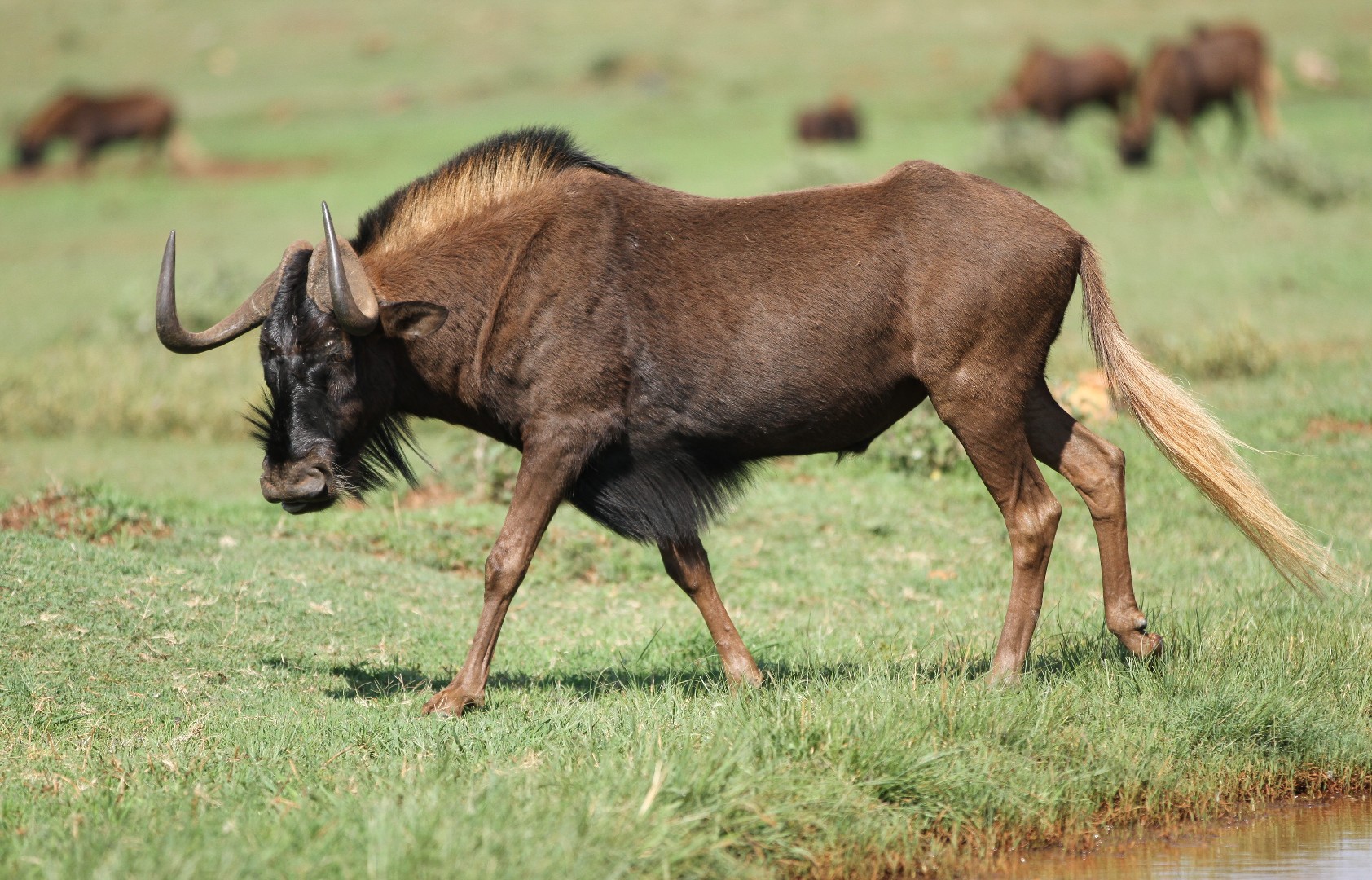Black wildebeest
A species of Wildebeests Scientific name : Connochaetes gnou Genus : Wildebeests
Black wildebeest, A species of Wildebeests
Scientific name: Connochaetes gnou
Genus: Wildebeests
Content
Description General Info
 Photo By Derek Keats , used under CC-BY-2.0 /Cropped and compressed from original
Photo By Derek Keats , used under CC-BY-2.0 /Cropped and compressed from original Description
Black wildebeest are sexually dimorphic, with females being smaller in size and more slender than males. The head-and-body length is typically between 170 and 220 cm (67 and 87 in). Males reach about 111 to 121 cm (44 to 48 in) at the shoulder, while females reach 106 to 116 cm (42 to 46 in). Males typically weigh 140 to 157 kg (309 to 346 lb) and females 110 to 122 kg (243 to 269 lb). A distinguishing feature in both sexes is the tail, which is long and similar to that of a horse. Its bright-white colour gives this animal the vernacular name of "white-tailed gnu", and also distinguishes it from the blue wildebeest, which has a black tail. The length of the tail ranges from 80 to 100 cm (31 to 39 in). The black wildebeest has a dark brown or black coat, which is slightly paler in summer and coarser and shaggier in the winter. Calves are born with shaggy, fawn-coloured fur. Males are darker than females. They have bushy and dark-tipped manes that, as in the blue wildebeest, stick up from the back of the neck. The hairs which compose this are white or cream-coloured with dark tips. On its muzzle and under its jaw it has black bristly hair. It also has long, dark-coloured hair between its forelegs and under its belly. Other physical features include a thick neck, a plain back, and rather small and beady eyes. Both sexes have strong horns that curve forward, resembling hooks, which are up to 78 cm (31 in) long. The horns have a broad base in mature males, and are flattened to form a protective shield. In females, the horns are both shorter and narrower. They become fully developed in females in the third year, while horns are fully grown in males at age of four or five. The black wildebeest normally has 13 thoracic vertebrae, though specimens with 14 have been reported, and this species shows a tendency for the thoracic region to become elongated. The scent glands secrete a glutinous substance in front of the eyes, under the hair tufts, and on the forefeet. Females have two teats. Apart from the difference in the appearance of the tail, the two species of wildebeest also differ in size and colour, with the black being smaller and darker than the blue. The black wildebeest can maintain its body temperature within a small range in spite of large fluctuations in external temperatures. It shows well-developed orientation behaviour towards solar radiation, which helps it thrive in hot, and often shadeless, habitats. The erythrocyte count is high at birth and increases till the age of 2-3 months, while in contrast, the leucocyte count is low at birth and falls throughout the animal's life. The neutrophil count is high at all ages. The haematocrit and haemoglobin content decreases till 20-30 days after birth. A peak in the content of all these haemological parameters occurs at the age of 2-3 months, after which the readings gradually decline, reaching their lowest values in the oldest individuals. The presence of fast-twitch fibres and the ability of the muscles to use large amounts of oxygen help explain the rapid running speed of the black wildebeest and its high resistance to fatigue. Individuals may live for about 20 years. 
General Info
Lifespan
10-20 years
Diet
Black wildebeest's fundamental diet consists mainly of grasses. It exhibits a dietary preference for short, green grass during the wet season. In the dry season, they consume longer, more mature grasses and occasionally browse on shrubby plants.
Appearance
The black wildebeest is a medium-sized ungulate with a broad, robust body covered in short, coarse fur. Its coloration varies from silvery-grey to dusky brown, complete with dark, vertical stripes on its sides. Prominent features include a mane of long, dark hair, a tufted tail, and sharp, upward-curving horns. Adult males generally possess larger horns and a darker mane than females. It has a characteristic white 'blaze' on its face, lending it a striking appearance.
Behavior
Black wildebeest primarily feeds on short grass, demonstrating a specific grazing technique of biting and twisting that avoids uprooting, hence promoting grass regrowth. The species migrates in large herds, presenting a unique spectacle. Distinctively, it kneels on calloused 'knees' when drinking. Primarily diurnal, territorial males vocalize and spread dung to mark territories. Predominantly peaceful, confrontations for dominance do occur.
Population
Increasing